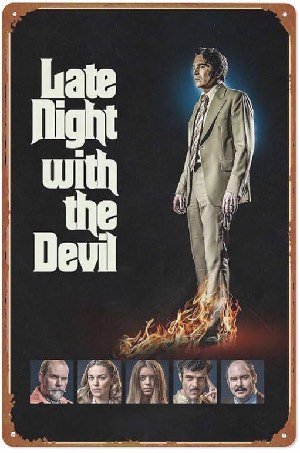
Late Night with the Devil
Recently, I went to the multiplex to see the horror film Stopmotion. It is wonderfully artistic, has some excellent performances, and an intriguing premise concerning an adult daughter being controlled by her celebrity filmmaker mother. The narcissistic mother suffers from acute arthritis in her hands which makes her unable to finish what will likely be her last stop motion film. She therefore requires her daughter to be literally hands on to complete the film, but satisfying a demanding artiste proves demoralizing and untenable. Those intense interpersonal dynamics and gripping stop motion visuals appeared to be laying the groundwork for potentially riveting psychological horror. Unfortunately, the movie veers into the standard clichés of exaggerated violence and subsequent body horror.
After that cinematic letdown, I hesitantly returned to the multiplex for another film in the genre. Late Night with the Devil proved to be the ideal antidote for my previous movie malaise. Smart and focused, the found footage-infused pseudo-documentary satirizes late night television extremes and the social/cultural madness of the 1970s. The plot focuses on late night show host Jack Delroy (portrayed by David Dastmalchian) who has been trailing Johnny Carson in the ratings for years. Delroy decides to resurrect his career following an untidy hiatus precipitated by his wife’s untimely death. As a return gimmick, his show “Night Owls” broadcasts a special occult-oriented Halloween Night extravaganza. The guests are glitzy psychic Christou (Fayssal Bazzi), stage magician turned debunker Carmichael Haig (Ian Bliss), parapsychologist/author June Ross-Mitchell (Laura Gordon) and the subject of her latest book adolescent Lilly (Ingrid Torelli), the sole survivor of a Satanic cult’s mass suicide. Lilly is purportedly possessed by a demon and the optimistic expectations for her to bring in a huge audience share run very high.
Carmichael Haig, who is clearly modeled on famous magician and debunker James Randi, is determined to provide rational explanations for anything on the show that could be construed as a supernatural manifestation. His disdaining demeanor and humiliation tactics alienate him from the show’s other guests. In a brilliantly orchestrated sequence, he hypnotizes the bulk of the show’s participants and much of the studio audience, and at one point faces the camera towards those of us in the movie theater. This breaking of the fourth wall for film audience inclusivity is effectively unnerving. The collective hypnosis is performed by Haig to illustrate the malleability of minds. But we all know that rationality cannot triumph over the arcane in a horror film.
Purported found footage displays the subsequent backstage upheaval including bitchy feuds, cover-ups, and ratings updates. The show’s sidekick is barely holding it together, and there are startling revelations. All of it is deliciously voyeuristic and satisfyingly surreal. A montage at the beginning of the film gives background about Delroy and “Night Owls” spliced in with real visuals depicting the era, such as photos of Johnny Carson and Charles Manson, which give the narrative a cinema verité feel. The movie also features a fabulous showcase of the theremin, which is in perfect harmony with the movie’s unusual tone.
Enough can’t be said of David Dastmalchian’s mesmerizing portrayal of Delroy, and the rest of the cast is stellar. Expertly written, edited, and directed by Colin and Cameron Cairnes, Late Night with the Devil restored my faith at a time when, loosely akin to Damian Karras from The Exorcist, I was starting to lose it. I am compelled again to believe in the power of horror films.

